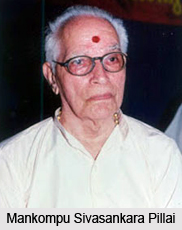 Mankompu Sivasankara Pillai was the master of the Kaplingatu (southern) school of Kadiakali. He was born as the nephew of the famous Kathakali actor Pachu Pillai and Kathakali singer Kuttan Pillai in Mankompu, near Ambalapuzha, Alappuzha district in 1922. He started his Kathakali training at the age of 13 under Kalarkode Kuttappa Panicker. After a few months, he joined the Kerala Kalamandalam in 1935 but left soon after, to learn under Thakazhi Ayyappan Pillai for three years.
Mankompu Sivasankara Pillai was the master of the Kaplingatu (southern) school of Kadiakali. He was born as the nephew of the famous Kathakali actor Pachu Pillai and Kathakali singer Kuttan Pillai in Mankompu, near Ambalapuzha, Alappuzha district in 1922. He started his Kathakali training at the age of 13 under Kalarkode Kuttappa Panicker. After a few months, he joined the Kerala Kalamandalam in 1935 but left soon after, to learn under Thakazhi Ayyappan Pillai for three years.
Mankompu Sivasankara Pillai debuted on stage as Lalita in Putana moksham or `Putana`s Moksha`, at the Mankompu Devi temple premises in 1938. He apprenticed in female characters under the famous Thottam Sankaran Namboodiri during 1881-1943. After four years, he joined the Chengannur Kalari and specialized mpaccha heroes during this period. During vacations, he toured with Chengannur Raman Pillai`s troupe for seven years and achieved renown. From 1948, he performed with Mrinalini Sarabhai`s troupe on many trips to Europe and South America. In 1974, he was appointed Kathakali instructor in Kerala Kalamandalam, from where he retired in 1983. Perfection in dress, rhythmic movements in cholliattam i.e. acting to songs, a wide range of bhavas, and the parameters of characterization prescribed by Raman Pillai are his plus points. He believes that a true guru must remain a sincere disciple throughout his career. This was the secret of his advanced style of bhavabhinaya.
This article is a stub. You can enrich by adding more information to it. Send your Write Up to content@indianetzone.com



















